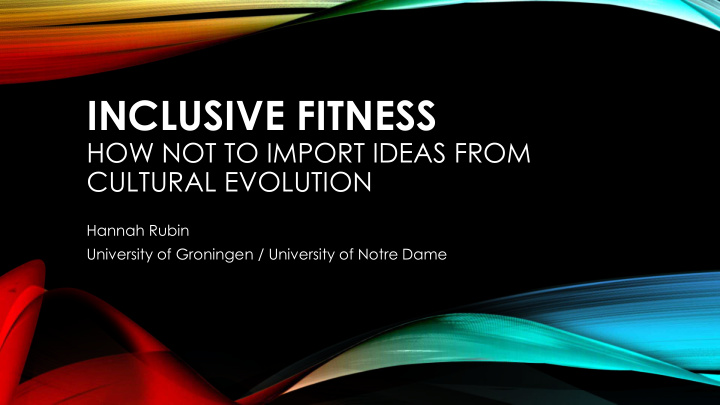



INCLUSIVE FITNESS HOW NOT TO IMPORT IDEAS FROM CULTURAL EVOLUTION Hannah Rubin University of Groningen / University of Notre Dame
West et al. (2011)
EXAMPLE • Inclusive fitness: 𝑠𝑐 − 𝑑
HAMILTON’S RULE 𝑠𝑐 − 𝑑 > 0
RELATEDNESS • Relatedness is a measure of correlation: 𝑠 = 𝑄 𝐵 𝐵 − 𝑄 𝐵 𝑂
RELATEDNESS • Relatedness is a measure of correlation: 𝑠 = 𝑄 𝐵 𝐵 − 𝑄 𝐵 𝑂 • Intuitively, captures how much an organism values its social partner’s reproductive success
OUTLINE 1. Heuristic calculations of inclusive fitness Joint work with Justin Bruner 2. The indispensability of inclusive fitness
THE HEURISTIC “Inclusive fitness and the problem of honest communication” with Justin Bruner
THE HEURISTIC • Simple-weighted sum: offspring + partner’s offspring × 𝑠
THE HEURISTIC • Simple-weighted sum: offspring + partner’s offspring × 𝑠
PROBLEMS • Double counting wrong equilibrium predictions (Grafen 1979, Skryms 2002, etc.)
PROBLEMS • Double counting wrong equilibrium predictions (Grafen 1979, Skryms 2002, etc.) • Response: gives necessary, but not sufficient conditions to be an equilibrium (Hines and Maynard Smith 1979)
PROBLEMS • Double counting wrong equilibrium predictions (Grafen 1979, Skryms 2002, etc.) • Response: gives necessary, but not sufficient conditions to be an equilibrium (Hines and Maynard Smith 1979) • Does not account for correlations wrong likelihood of outcomes
THE HEURISTIC “Relatedness might, beyond inclusive fitness, introduce additional correlation” (Zollman 2013, p. 131)
SIR PHILIP SIDNEY
SIR PHILIP SIDNEY • Cost to signal • Cost to donate • Probability of being needy • Benefit to needy > benefit to healthy
SIR PHILIP SIDNEY • Cost to signal • Cost to donate • Probability of being needy • Benefit to needy > benefit to healthy • Model using the heuristic (Huttegger and Zollman 2010)
• Evolution with clones • The heuristic: signaling unlikely • Personal fitness: signaling is the only outcome
• Evolution with clones • The heuristic: signaling unlikely • Personal fitness: signaling is the only outcome
INDISPENSABILITY “Does inclusive fitness save the connection between rational choice and evolution?”
INDISPENSABILITY “…it allows social behaviour, even when it is individually costly, to be understood from the perspective of an individual organism ‘trying’ to achieve a goal, thus preserving Darwin's insight that selection will lead to the appearance of design in nature.” (Okasha et al. 2014, p. 28)
MAXIMIZING AGENTS • Personal fitness cannot do this (Skyrms 1994, Sober 1998, etc.) • Evolution takes correlations into account • Rational actors should not (in general) take correlations into account
INDISPENSABILITY “The individual does not, in general, have full control of its [personal] fitness, as parts of this are mediated by the actions of her social partners. However, the individual does have full control of inclusive fitness, as this is explicitly defined in terms of the fitness consequences for itself and others that arise out of its actions” (West and Gardner, 2013, R579-R580)
WHAT IS THE DECISION PROBLEM? • Keeping its social environment fixed: 1. Fixed social neighborhood 2. Fixed relatedness
FIXED NEIGHBORHOOD parent social you partner (sibling)
FIXED NEIGHBORHOOD ?
FIXED NEIGHBORHOOD
FIXED NEIGHBORHOOD 3 7 3 7 𝑄 𝐵 𝐵 = 𝑄 𝑂 𝐵 = 𝑄 𝐵 𝑂 = 𝑄 𝑂 𝑂 = 10 10 10 10
FIXED NEIGHBORHOOD Inclusive Fitness: 𝑠𝑐 − 𝑑 3 7 3 7 𝑄 𝐵 𝐵 = 𝑄 𝑂 𝐵 = 𝑄 𝐵 𝑂 = 𝑄 𝑂 𝑂 = 10 10 10 10
FIXED RELATEDNESS • Kith selection: an organism’s trait influences their social partner’s trait social you partner
FIXED RELATEDNESS ? ? ? ? ? ? ? ? ? ? ?
FIXED RELATEDNESS
FIXED RELATEDNESS 8 2 2 8 𝑄 𝐵 𝐵 = 𝑄 𝑂 𝐵 = 𝑄 𝐵 𝑂 = 𝑄 𝑂 𝑂 = 10 10 10 10
INDISPENSABILITY? • We can explain social behavior as adaptive using inclusive fitness iff we can do so using personal fitness
SUMMARY
THANKS!
SELECTED REFERENCES • Bruner, J.P. and H. Rubin (forthcoming) Inclusive fitness and the problem of honest communication. BJPS • Grafen, A. (1979) The hawk-dove game played between relatives. Animal behaviour , 27:905-907. • Hines, W. G. S. and J. Maynard Smith (1979) Games between relatives. Journal of Theoretical Biology , 79(1):19-30. • Huttegger, S. and K. Zollman (2010). Dynamic stability and basins of attraction in the Sir Philip Sidney game. Proc. R. Soc. B 277, 1915-1922. • Okasha, S., J. A. Weymark, and W. Bossert (2014). Inclusive fitness maximization: An axiomatic approach. Journal of theoretical biology, 350, 24-31. • Skyrms, B. (1994). Darwin meets the logic of decision: Correlation in evolutionary game theory. Philosophy of Science , 61 (4), 503-528. • Skyrms, B. (2002) Altruism, inclusive fitness, and the logic of decision. Philosophy of Science, 69:S104- 111. • Sober, E. (1998). Three differences between deliberation and evolution. Modeling rationality, morality, and evolution (7), 408-22. • West, S. A., C. El Mouden, and A. Gardner (2011). Sixteen common misconceptions about the evolution of cooperation in humans. Evolution and Human Behavior 32 (4), 231-262. • West, S. A. and A. Gardner (2013). Adaptation and inclusive fitness. Current Biology 23 (13), R577- R584. • Zollman, K (2013). Finding alternatives to the handicap principle. Biological Theory 8,127-132.
Recommend
More recommend